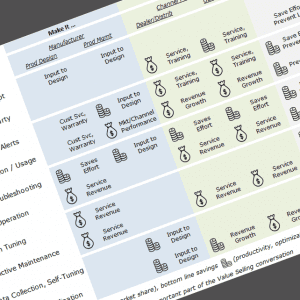Three more types of tech challenges that come up in conversations about Smart, Connected Products. The details are interesting, but the higher-level insights are very informative.
As previously noted, the focus of our IoT conversations is not all strategy, markets, and business cases. Each new Business Unit (BU) connection brings more anecdotes about things that start off as puzzles and end up as interesting insights, decisions to reduce complexity, and/or necessary evils.
Talking with product engineers about their work in a smart, connected world leads to some interesting changes in perspective and turns of the conversation. It’s always a huge educational opportunity for me, as I learn about the depth and detail of knowledge that our specialty manufacturing BUs possess – and some have already been thinking about IoT concepts and how they might apply. But I do get a chance to toss a few “uneducated” ideas into the mix, cross-pollinating with ideas for other BUs. When presented with such possibilities, the mind will pause for a moment .. always fun to see the light building in their eyes when open conversation turns over a nugget of new thought.
The reality is that all of us naturally bound our thinking and imagination to a certain extent – based on how we were trained, and the ways in which we understand how to get stuff done. Some are able to quickly pull in alternative points of view – others, maybe not so much. I see analogies to the additive manufacturing (3D printing) world – technology that opens up new vistas in product design, with product geometry that were previously impossible to create. But since I [the Product Engineer] have built a career on delivering quality products at scale – based on what I know how to make – my design imagination may develop boundaries based on what I know how to manufacture. For example – in my drive to reduce weight and material use in my products, I could never design seamless material voids, because the manufacturing process didn’t exist – until 3D printing came along. The challenge now is to see how fast designers and engineers can take their feet off the brakes and incorporate this new thinking.
Can we open our minds when it comes to the Internet of Things? Based on our internal conversations, I think the answer is yes – with the right kind of prodding.
A New Point of View
For example – Company O has had access to real-time on-board streaming data for some time now – but has primarily been using this access to re-program on-board controllers. The data streaming past them was only used for instrumentation – valuable, and somewhat expected (hence all the gauges and meters they were replacing). But to date they hadn’t looked to collecting and storing the data for later use.
What types of performance characteristics and trends could we suss out from such data? This question sparked some energy, but the conversation quickly turned to data storage; one of the underlying challenges was the large volumes of data to collect. Where to store it all? We talked about current-state memory and storage, did some math on the data size – nothing that couldn’t fit on a micro-SD card, so it became something of a non-issue. Oh, we still have to work out the details – but once they started to understand there was value in the data and a potential solution for storage, the ideas started flowing.
Consumer ‘Wow’ for BtoB?
Company L has started to tackle the development platform issue – iOS or Android? These conversations typically start with the over-application of consumer-based thinking – all apps need to run on an iPhone because it’s cool, or on an Android because it has share. The latter is closer to the truth – the last survey I saw had Android selling more units by far – but this is being driven by huge volumes of low-priced units in Asia. Others will argue that iOS is currently actively in use in 40% of phones (but focused on the US). So, good point – a large share of our target market is probably using iOS – but not the majority, and (if we are marketing globally), not necessarily true for our total customer base.
There’s a bit of a “deer in the headlights” effect as folks try to answer the question on how to proceed – but there are a few simple answers …
- Talk to your Customers: You may find the early adopters have a clear preference – but if you are looking for deep market penetration, don’t let that limit your thinking. A reasonably complete sampling will give you an indication of the split between Android, iOS, and “other”, and put real numbers behind the need for multi-platform development thinking.
- Consider HTML5: The debate between the consumer-centric need for “native” application functionality (matching the norms of the platform and the expectations of platform “purists”) and the provider’s desire to minimize complexity (with an HTML5 / CSS / Javascript approach that aspires to a single, cross-platform code base). I currently am counseling folks to take this road – it’s the “things” and the data being collected by / for them that are the core value for our customers – not the fancy mobile app experience.
Design & Code: Internal vs. External Resources
Another interesting conversation balances between the need for speed and the long-term cost of ownership for a product offering. We are starting these “difficult” conversations (introducing wildly new ideas about the nature of our products and services) – it’s only natural that the engineering and marketing teams do not have the specific digital skills required. I have met the the folks on many of our Product Line teams, and there is some impressive talent there – but new is new, and the core requirements are for speed-to-market (faster!) and features (more!). The key question to ask: how long will it take to develop the skills internally – and do we want to wait that long?
I typically talk with the BUs about leveraging external resources to jump start the product development process, with the expectation that over time, the specific digital skills can be insourced. It’s important to note, by the way, that the missing skills are things like mobile app design, working with unstructured data, DevOps and fast-fail development – not the easiest skills to locate. And if we go the partnering route to bring those skills on board faster, we will quickly need to develop vendor- and project-management skills that will be very different from the outsourced manufacturing processes we are used to dealing with.
By the way, there is a flip-side challenge with the outsourcing model; most firms are still operating under a semi-waterfall, custom software development model that supports big, multi-month projects with masses of programmers – projects that come to and end with a big deliverable and a go-live event. The problem? If you are changing the market, your customers, your products, and your internal processes – making such profound changes – you probably do not fully understand the future state, nor do you completely understand what the reaction will be. Better to follow ideas from the lean startup way of thinking, where Minimum Viable Products are created and quickly iterated, and product development is a continuous, evolving process. For external partners, this is a different way of thinking – sounds almost like staff augmentation, which may firms actively seek to avoid. Yet another problem challenge opportunity for learning …
19 January, 2015
- IoT Field Notes: Whiteboard Wireframing
- IoT Field Notes: Solving Interesting Tech Challenges 2
- IoT Field Notes: Solving Interesting Tech Challenges
- IoT Field Notes: Listening to the Voice of the Customer
- IoT Field Notes: Muddled Marketing Messages






Comments (0)